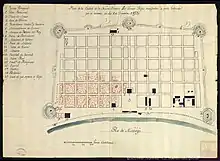Great New Orleans Fire (1794)
The Great New Orleans Fire (1794) was a fire that destroyed 212 structures in New Orleans, Louisiana on December 8, 1794, in the area now known as the French Quarter from Burgundy to Chartres Street, almost to the riverfront buildings.[1][2] Another 856 buildings had been destroyed 6 years earlier, in the First Great New Orleans Fire on March 21, 1788.[1]


History
The fire started on December 8, 1794.
The fire area stretched across 212 buildings, including the royal jail.[1] It spared the Mississippi River front buildings. Among the buildings spared were the Customs House, the tobacco warehouses, the Governor's Building, the Royal Hospital, and the Ursulines Convent. Despite widespread fire damage, the St. Louis Cathedral was not destroyed but was dedicated just 2 weeks later, on December 23, 1794.
Afterward, the schooner Nuestra Señora del Cármen was used as a temporary jail during the period December 10, 1794 to February 26, 1795. The ship's owner, Don Prospero Ferrayolo, received rental payments for use of the ship, replacing the royal jail destroyed during the fire.[2]
The Spanish were to replace the wooden buildings with structures with courtyards, thick brick walls, arcades, and wrought iron balconies.[1] Among the new buildings were the signature New Orleans buildings of St. Louis Cathedral (1794), the Cabildo (1799), and the Presbytere (1797), all designed by Gilberto Guillemard.[2]
In 1795, Don Andrés Almonaster y Rojas had agreed to pay for construction of the building now known as the Cabildo. It replaced an earlier structure that had been destroyed by the fire. Almonester had already commissioned Gilberto Guillemard to design the new cathedral and Presbytere.
Just 6 years earlier, on March 21, 1788, another 856 buildings had been destroyed in the Great New Orleans Fire (1788). Still a colony of Spain, rebuilding after both fires continued in Spanish style, and most French architecture was eliminated from the French Quarter.[1]
See also
- The Cabildo - house of government in Spanish period.
Notes
- "French Quarter Fire and Floord". New Orleans French Quarter. Retrieved 18 May 2015.
- "A Great and Growing City". Nutrias. Retrieved 18 May 2015.
References
- Episodes of Louisiana Life by Henry C. Castellanos - 1905 (includes full text of Miro's report on fire)
- Encyclopedia Louisiana
- "French Quarter Fire and Flood" (history), FrenchQuarter.com, 2007, webpage: FQ-History-elements (top paragraphs).